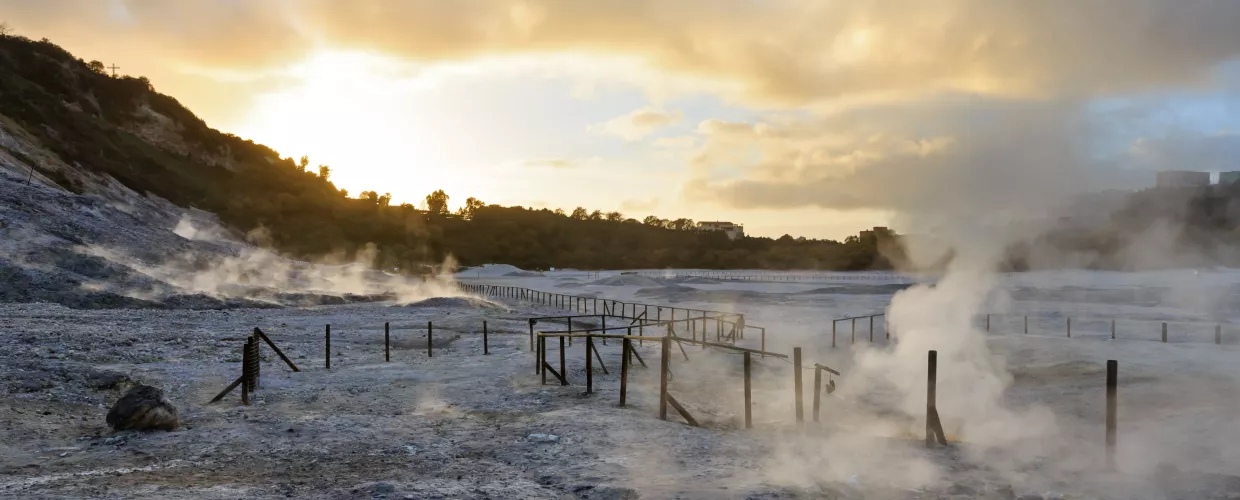This content was automatically translated. View the original text.

Overview
Discovering the Campi Flegrei, between myth and well-being
Between the municipalities of Pozzuoli, Bacoli, Monte di Procida, the islands of Ischia, Procida and Vivara lies the vast volcanic area of the Campi Flegrei, technically an ancient caldera , or dormant supervolcano, one of the few on the earth's surface.
Here, it is possible to see several small craters, some of which are characterised by solfataras, effusive gaseous manifestations, others by hydrothermal phenomena.
The Campi Flegrei in mythology
Such an evocative place could not fail to fuel myths. The Greek colonists, for example, believed that this land was the tomb of some giants defeated by Hercules on behalf of Zeus.
According to legend, the giants wanted to usurp the king of the gods, and were punished for their recklessness. It is precisely from this that the name Phlegraean derives: it goes back, in fact, to the Greek word flego, meaning ardo. In the myth, it was the wounds of the giants that burned: provoked by the divine thunderbolt, they produced fire and water.
Even Virgil, in theAeneid, mentions the Phlegraean area as the burial place of these mythological characters. It is no coincidence that Aeneas begins his descent into the underworld from Lake Avernus, located precisely in the Campi Flegrei. The myth should not be underestimated: beyond the fanciful interpretations, it offers a vivid picture of volcanic activity at the time.
Cumae, the first Greek colony in Italy
The geophysical characteristics of the Phlegraean Fields make the area particularly fertile, and thanks also to the mild climate, the ancient Greeks had already built some of their cities there: the most famous was Cumae, the first Hellenic colony in Magna Graecia. Today in Cumae you can visit the Acropolis, which includes the Sybil's Cavern at the base of the hill, while going up towards the fortress there are the Byzantine Tower with the Belvedere, the Temple of Apollo and the Temple of Jupiter also known as the Lower Terrace and the Upper Terrace. Converted into churches in the Middle Ages, the two temples retain traces of both their origins and their later use.
The Campi Flegrei thermal tradition
It was not, however, only myth that fuelled the fame of the Campi Flegrei.
Due to the volcanic activity, this area was chosen by the ancient Romans as their favourite spa area.
While in Rome, in fact, it was necessary to wait for the baths' rooms and water to heat up thanks to an underground system of fireplaces, in Cumae and its surroundings there were no such procedures: this is why many decided to have their patrician villas built here, to relax and enjoy the beauty of the place.
Baia, the sunken city
The most famous was the Pausilypon, erected by the freedman Publius Vedius Pollonius, who left it to Augustus upon his death. Does this remind you of anything? Yes, the Promontorio di Posillipo owes its name to this very dwelling.
Epicentre of wealth, Baia, frequented by Julius Caesar and Nero, Pompey and Hadrian; an irresistible pole of attraction. Much of what we know today about this ancient city we owe to Pliny the Elder, commander of the Roman imperial fleet in nearby Misenum.
The boiling water gushed from underground along with its vapours, and both were exploited in saunas carved into the rock. A perfect place to spend idle hours; only with the decline of the Empire did this come to an end.
Today, the ancient Bay no longer exists. It is a completely submerged area due to the bradyseism, a volcanic phenomenon that led to the sinking of the coastline.
Also called The Sunken Pompeii, because it is very similar urbanistically, ancient Baia falls within a protected marine area.
Much of what characterised it can be seen at the Campi Flegrei Archaeological Museum at the Aragonese Castle. Don't miss it if you want to get an idea of what this wonderful location, beloved of Roman patricians, might have beenlike.
Campi Flegrei, 80078 Pozzuoli NA, Italia